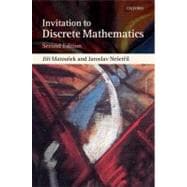
Note: Supplemental materials are not guaranteed with Rental or Used book purchases.
Purchase Benefits
What is included with this book?
| Introduction and basic concepts | p. 1 |
| An assortment of problems | p. 2 |
| Numbers and sets: notation | p. 7 |
| Mathematical induction and other proofs | p. 16 |
| Functions | p. 25 |
| Relations | p. 32 |
| Equivalences and other special types of relations | p. 36 |
| Orderings | p. 43 |
| Orderings and how they can be depicted | p. 43 |
| Orderings and linear orderings | p. 48 |
| Ordering by inclusion | p. 52 |
| Large implies tall or wide | p. 55 |
| Combinatorial counting | p. 59 |
| Functions and subsets | p. 59 |
| Permutations and factorials | p. 64 |
| Binomial coefficients | p. 67 |
| Estimates: an introduction | p. 78 |
| Estimates: the factorial function | p. 85 |
| Estimates: binomial coefficients | p. 93 |
| Inclusion-exclusion principle | p. 98 |
| The hatcheck lady & co. | p. 103 |
| Graphs: an introduction | p. 109 |
| The notion of a graph; isomorphism | p. 109 |
| Subgraphs, components, adjacency matrix | p. 118 |
| Graph score | p. 125 |
| Eulerian graphs | p. 130 |
| Eulerian directed graphs | p. 138 |
| 2-connectivity | p. 143 |
| Triangle-free graphs: an extremal problem | p. 148 |
| Trees | p. 153 |
| Definition and characterizations of trees | p. 153 |
| Isomorphism of trees | p. 159 |
| Spanning trees of a graph | p. 166 |
| The minimum spanning tree problem | p. 170 |
| Jarník's algorithm and Borůvka's algorithm | p. 176 |
| Drawing graphs in the plane | p. 182 |
| Drawing in the plane and on other surfaces | p. 182 |
| Cycles in planar graphs | p. 190 |
| Euler's formula | p. 196 |
| Coloring maps: the four-color problem | p. 206 |
| Double-counting | p. 217 |
| Parity arguments | p. 217 |
| Sperner's theorem on independent systems | p. 226 |
| An extremal problem: forbidden four-cycles | p. 233 |
| The number of spanning trees | p. 239 |
| The result | p. 239 |
| A proof via score | p. 240 |
| A proof with vertebrates | p. 242 |
| A proof using the Prufer code | p. 245 |
| Proofs working with determinants | p. 247 |
| The simplest proof? | p. 258 |
| Finite projective planes | p. 261 |
| Definition and basic properties | p. 261 |
| Existence of finite projective planes | p. 271 |
| Orthogonal Latin squares | p. 277 |
| Combinatorial applications | p. 281 |
| Probability and probabilistic proofs | p. 284 |
| Proofs by counting | p. 284 |
| Finite probability spaces | p. 291 |
| Random variables and their expectation | p. 301 |
| Several applications | p. 307 |
| Order from disorder: Ramsey's theorem | p. 317 |
| A party of six | p. 318 |
| Ramsey's theorem for graphs | p. 319 |
| A lower bound for the Ramsey numbers | p. 321 |
| Generating functions | p. 325 |
| Combinatorial applications of polynomials | p. 325 |
| Calculation with power series | p. 329 |
| Fibonacci numbers and the golden section | p. 340 |
| Binary trees | p. 348 |
| On rolling the dice | p. 353 |
| Random walk | p. 354 |
| Integer partitions | p. 357 |
| Applications of linear algebra | p. 364 |
| Block designs | p. 364 |
| Fisher's inequality | p. 369 |
| Covering by complete bipartite graphs | p. 373 |
| Cycle space of a graph | p. 376 |
| Circulations and cuts: cycle space revisited | p. 380 |
| Probabilistic checking | p. 384 |
| Appendix: Prerequisites from algebra | p. 395 |
| Bibliography | p. 402 |
| Hints to selected exercises | p. 407 |
| Index | p. 433 |
| Table of Contents provided by Ingram. All Rights Reserved. |
The New copy of this book will include any supplemental materials advertised. Please check the title of the book to determine if it should include any access cards, study guides, lab manuals, CDs, etc.
The Used, Rental and eBook copies of this book are not guaranteed to include any supplemental materials. Typically, only the book itself is included. This is true even if the title states it includes any access cards, study guides, lab manuals, CDs, etc.